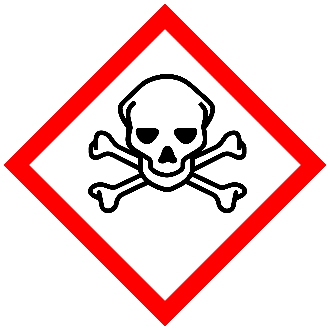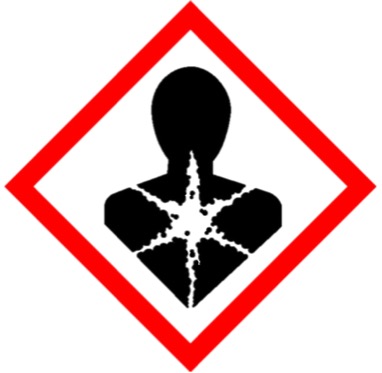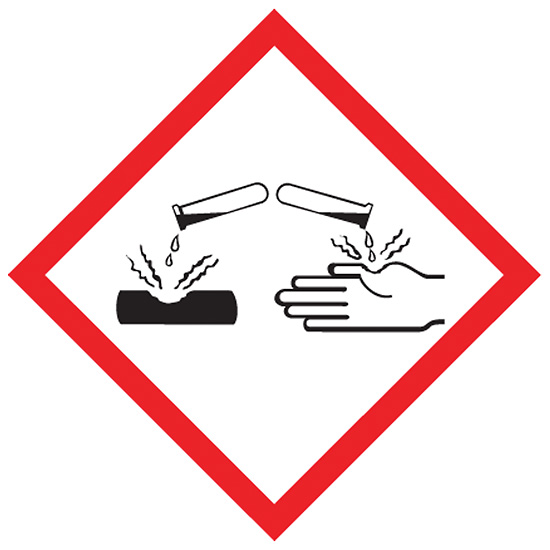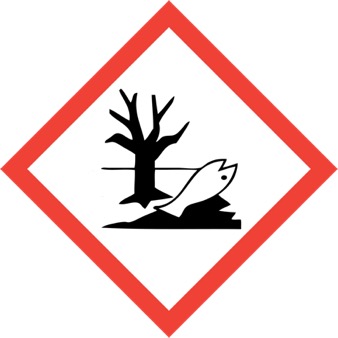Last Revised: April 12, 2024
Revision 9/2018 (original)
The requirements in Penn's Chemical Hygiene Plan SOP: Acutely Toxic Chemicals and SOP: Corrosives apply to all work involving tetramethylammonium hydroxide solutions (CAS#75-59-2). The Fact Sheet below gives hazard information and precautions for working with this chemical; however, this information is provided as a supplement to the SOPs, which must first be read and understood by anyone planning to work with this chemical.
General Description and Uses
Tetramethylammonium Hydroxide (TMAH) is available in solution and in the pentahydrate form as a white crystalline solid. The pentahydrate CAS# is 10424-65-4.
TMAH solution is widely used in the electronics industry as a developer or cleaner. TMAH is typically one of several ingredients in etching / stripping mixtures, although it may also be used as a pure chemical. It is often used in solution in water, and less frequently, in methanol. These solutions are assigned the CAS# 75-59-2. The concentration of TMAH in commercially available developers used on Penn’s campus is <3% (according to chemical inventory records 9/2018). The highest concentration solution of TMAH that is commonly available commercially is 25%. TMAH is a strong base; the 25% solution in water has a pH of greater than 13.
The odor of TMAH has been described as a strong, ammonia-like smell. Although pure TMAH will have virtually no odor, solutions may give off a fishy smell from triethylamine, which is a common impurity.
Hazard Description
Refer to a specific product’s Safety Data Sheet for more hazard details. An example Safety Data Sheet from Sigma-Aldrich for a 25% solution of TMAH can be found here: Sigma-Aldrich SDS for TMAH 25%
The health hazards of TMAH pentahydrate (solid) are very similar to those of the solution, however the solid is a GHS hazard category 3 for dermal acute toxicity, whereas the solution is a GHS hazard category 2 (higher hazard) for dermal acute toxicity. This difference in hazard category is likely due to the increased risk of dermal absorption of the chemical in solution.
Health Hazards
GHS Classification Information from the Sigma-Aldrich SDS for the TMAH 25% Solution in Water:
Acute toxicity, Oral (Category 2), H300
Acute toxicity, Dermal (Category 2), H310
Skin corrosion (Category 1), H314
Serious eye damage (Category 1), H318
Specific target organ toxicity - single exposure (Category 1), Central nervous system, H370
Specific target organ toxicity - repeated exposure, Dermal (Category 1), thymus gland, Liver, H372
Acute aquatic toxicity (Category 2), H401
Chronic aquatic toxicity (Category 2), H411
Pictograms




Hazard statement(s)
Signal word: Danger
- H300 + H310 Fatal if swallowed or in contact with skin
- H314 Causes severe skin burns and eye damage.
- H318 Causes serious eye damage.
- H370 Causes damage to organs (Central nervous system).
- H372 Causes damage to organs (thymus gland, Liver) through prolonged or repeated exposure in contact with skin.
- H411 Toxic to aquatic life with long lasting effects.
TMAH is extremely corrosive to skin, eyes, and mucous membranes and will cause serious burns to eyes, and skin on contact.
In addition to causing chemical burns, TMAH can cause systemic neurotoxicity leading to respiratory failure by ganglion block that occurs through skin absorption. No antidote has been developed yet.
Symptoms of Exposure
The following exposure information is from the U.S. Library of Medicine Toxicology Data Network (TOXNET):
INHALATION EXPOSURE: Mild exposure may cause cough and bronchospasm. Severe inhalation may cause upper airway edema and burns, stridor, and rarely acute lung injury.
OCULAR EXPOSURE: Ocular exposure can produce severe conjunctival irritation and chemosis, corneal epithelial defects, limbal ischemia, permanent visual loss and in severe cases perforation.
DERMAL EXPOSURE: Mild exposure causes irritation and partial thickness burns. Metabolic acidosis may develop in patients with severe burns or shock. Prolonged exposure or high concentration products can cause full thickness burns.
Systemic toxicity is likely to occur with dermal exposure.
Physical Hazards
When heated to decomposition, TMAH emits toxic fumes of NOx and ammonia.
Approvals
A Hazard Control Plan is recommended for procedures involving TMAH over 5%, and one may be required by EHRS under certain circumstances.
Contact EHRS for assistance with your hazard assessment.
All work with TMAH requires the approval of the P.I. The P.I. must ensure that the person or team who will be working with the chemical writes a task-specific Hazard Control Plan (HCP) if required by EHRS or the P.I.'s hazard assessment.
The HCP must be sent to EHRS for review. EHRS will upload the HCP to the “documents” section of the lab’s BioRAFT page.
The P.I. must also ensure that the person or team who will be working with the chemical understands the hazards and has received adequate training and supervision for the procedure.
Safe Handling and PPE
All of the handling procedures detailed in SOP: Acutely Toxic Chemicals and SOP: Corrosives apply to all work involving tetramethylammonium hydroxide solutions.
Because TMAH exposures to skin and eyes will result in serious burns, and because dermal absorption may result in fatal systemic toxicity, risk assessments for work involving TMAH may determine a level of required personal protective equipment (PPE) that is beyond the minimum mandatory laboratory PPE requirements, i.e. safety glasses, lab coat, disposable nitrile gloves, closed-toed shoes, and long pants.
Additional recommended PPE includes:
- Chemical-resistant apron
- Chemical splash goggles
- Nitrile gloves* with long gauntlets to protect the wrist/arm
*Note that Glove-manufacturer’s compatibility charts do not often include data specifically for TMAH; however, the 4-mil disposable nitrile rubber gloves commonly used in the laboratory will provide adequate protection against incidental contact with TMAH solutions. This is based on the information from the Sigma-Aldrich SDS. Testing was done on a 0.11 mm (4.33 mil) nitrile glove.
Full contact Material: Nitrile rubber Minimum layer thickness: 0.11 mm Break through time: 480 min Material tested:Dermatril® (KCL 740 / Aldrich Z677272, Size M)
Storage and Transport
See Section VI: Chemical Storage and Transportation, SOP: Acutely Toxic Chemicals and SOP: Corrosives in this CHP for a complete list of requirements for storage and transportation of toxic and corrosive chemicals.
Specific storage instructions for TMAH solutions (from the Sigma-Aldrich SDS) also include:
Keep container tightly closed in a dry and well-ventilated place. Store under inert gas. Air sensitive. hygroscopic.
Waste and Decontamination
Do not combine waste streams containing TMAH with other chemical waste. Collect all TMAH separately, and store and label it according to the hazardous waste management guidelines.
For complete hazardous waste guidelines, see the waste section of the EHRS website: Laboratory Chemical Waste Management Guidelines
Emergencies
All exposures or potential exposures to TMAH require immediate medical attention.
Emergency Contacts
General emergency response information can be found at Emergency Info
Spills
General procedures for chemicals spill response can be found in Section X: Chemical Spills in this CHP.
Do not hesitate to call EHRS for assistance with spill cleanup for Acutely Toxic and Corrosive Materials
24 hours: 215-898-4453
Contact Penn Police (511) only if the spill involves a fire, imminent risk of fire, an injury requiring an ambulance, or if there is a hazard that may affect others in the building.